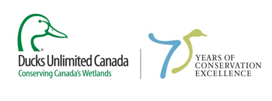Ducks Unlimited Asian Carp Agreement
An international agreement to address non-native carp in the Great Lakes
An international agreement to address non-native carp in the Great Lakes
The introduction and proliferation of non-native Asian carp throughout the Great Lakes and their adverse impacts on waterfowl and wetland ecosystems
The five Great Lakes are under threat from a number of non-native fish species commonly referred to as Asian carp. These include the silver, bighead, grass and black carp. Asian carp pose a serious threat to waterfowl and wetlands within the Great Lakes region if they establish breeding populations in the lakes. The grass and black species of Asian carp would directly impact waterfowl habitat, and the silver carp pose a potential indirect impact to outdoor recreational activities and people who hunt, fish or recreate in boats. The appetite of the non-native carp is voracious; grass carp daily eat their body weight in submersed aquatic vegetation (SAV) which is important as food for waterfowl and a basic energy source for the Great Lakes food web. Black carp feed on mollusks and snails. Non-native silver carp pose a threat to recreation enthusiasts because they have a tendency to jump out of the water at the sound of a boat motor.
The United States Army Corps of Engineers (USACOE) Great Lakes Mississippi River Interbasin study (GLMRIS) is currently underway outlining recommendations for preventing the spread of non-native carp into the Great Lakes ecosystem, with a final report expected December 2013. On the Canadian side, the federal Department of Fisheries and Oceans and the Ontario Ministry of Natural Resources have developed a coordinated strategic response plan including monitoring for Asian carp. The long term actions required are dependent upon research findings, but will most likely include a combination of barriers to each entry vector and the full-ecological separation of the Great Lakes and Mississippi River Basins in the Chicago Area Waterway System and other potential areas. Ecological separation is outlined as the best option in the long-term to prevent Asian carp and other aquatic invasive species (AIS) from entering the Great Lakes. This assessment is based on a report, "Restoring the Natural Divide, Separating the Great Lakes and Mississippi River Basins in the Chicago Area Waterway System," released by the Great Lakes Commission and the Great Lakes/St. Lawrence Cities Initiative. Other strategies to prevent interbasin transfer of AIS include improved laws and enforcement to prevent live transport and other contamination actions.
Non-native grass carp and black carp feed on foods critical to waterfowl (SAV and snails). This competition could reduce the availability of food to waterfowl in high priority breeding and migratory habitats in the Great Lakes watershed of both countries. Carp foraging behavior also leads to the re-suspension of sediments that can negatively impact water quality and SAV abundance. The jumping of the silver carp also poses a threat to waterfowlers and other outdoor recreationists due to the potential for injury. In order to ensure full skies of waterfowl for today, tomorrow and forever; waterfowl need good wetland habitat, good water quality and suitable food sources to survive and the Asian carp could negatively impact DU's objectives in the Great Lakes.
The containment of non-native Asian carp species from establishing breeding populations in the Great Lakes watershed is critical to protecting important breeding and migratory habitats along the Great Lakes. Depletion of food resources for migratory waterfowl could impact breeding success and overwintering survival of waterfowl across much of North America. Preventing non-native Asian carp from establishing breeding populations will also help prevent a significant adverse impact on the Great Lakes entire food chain, species diversity and ecological sustainability. The best long-term solution would be to ecologically separate the Great Lakes and Mississippi River basins utilizing barriers and other means at points of entry to the Great Lakes to prevent interbasin transfers of invasive species.
DU and DUC have had limited engagement on this issue with both governmental and non-governmental organizations at regional, state, provincial and federal levels within the Great Lakes basin. DU is a member of the Healing Our Waters coalition, which has advocated on behalf of the health of the Great Lakes at specific events and meetings, further educating legislators, partner organizations and others of the potential impact of an Asian carp proliferation. DU has also been monitoring the progress of the GLMRIS and encouraging the USACOE to ensure the results of the study are available as soon as possible and outline definitive actions. Informally, at the federal level, DU has engaged in Washington, D.C. with other Great Lakes stakeholders to illustrate the gravity of this situation. DU has assisted in coordinated letters to Congress, more specifically members of the Great Lakes states' delegations, on behalf of both members and other individuals such as Great Lakes state governors, mayors, business owners, recreationist enthusiasts, etc., encouraging them to act and prevent non-native Asian carp from entering the Great Lakes. Furthermore, DU has helped garner broad (non-DU) grassroots support for various actions including action alert sending, letter sending, phone calls, testifying, etc., to ensure concerns are heard at the federal level. On the Ontario side most of the initiatives have been undertaken by the Department of Fisheries and Oceans, the Ontario Ministry of Natural Resources and the Ontario Federation of Anglers and Hunters
 |
 |
Ducks Unlimited uses cookies to enhance your browsing experience, optimize site functionality, analyze traffic, and deliver personalized advertising through third parties. By continuing to use this site, you agree to our use of cookies. View Privacy Policy